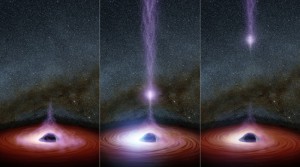How a Black Hole Flares
X-ray observations suggest that flares happen when a black hole's "atmosphere" contracts and launches away from it.
Black holes are paradoxically some of the brightest objects in the universe. It’s not the black holes themselves that are bright; it’s their entourages. Surrounding these spacetime warps are glowing disks of hot gas, which can feed blazing jets and flares.
Astronomers regularly watch black holes flare, but they’re not actually sure why flares happen. New X-ray observations suggest that these brilliant surges are a sort of physics-engendered optical effect, created by changes in a mysterious structure called the corona.

This artist's illustration shows a supermassive black hole surrounded by a swirling accretion disk. The purplish glow represents the corona, which contains highly energetic particles that generate X-ray light. X-ray observations suggest that, when a black hole appears to flare in X-rays, it's actually the corona that's changing. The corona gathers inward (left), becoming brighter, before shooting away from the black hole (middle and right). Astronomers don't know why the coronas shift, but they have learned that this process leads to a brightening of X-ray light that can be observed by telescopes.
NASA / JPL-Caltech
NASA / JPL-Caltech
The corona is a haze of high-energy electrons that hovers over the black hole and its accretion disk. The electrons whiz around with so much energy that when they collide with ultraviolet photons flying away from the disk, they give a mighty kick that turns those photons into X-rays. These X-rays in turn reflect back off the accretion disk, carrying away spectral fingerprints from the disk that reveal things like how fast the black hole is spinning.
Although astronomers know the corona is there, they don’t know exactly what it looks like — it might be a compact “light bulb” shining on the disk, an extended cloud, or, to steal a metaphor from JPL’s press release, the sandwich bread on either side of the disk’s ham.
Dan Wilkins (Saint Mary’s University, Canada) and colleagues explored what makes a flare happen by observing the active black hole at the center of the galaxy Markarian 335, which lies roughly 350 million light-years away in the constellation Pegasus. Mrk 335 is well known for its fits of brilliance, its X-ray emission rising and falling at whim. Previous observations have hinted that these changes come with changes in the corona’s structure.
The team used the Swift and NuSTAR space telescopes to watch how Mrk 335’s X-ray emission changed during a month-long flare in September 2014. They noticed that, even though the corona was bright and compact during the flare, the disk was reflecting less than half of the X-rays expected. The corona was still clearly producing X-rays, but for some reason, most of these photons weren’t hitting the disk.
The team thinks that, before a flare, the corona spreads out across the disk’s surface. Then it gathers itself together, like a cat preparing to spring — except instead of a ball of fur and nails, it contracts into a vertical, jetlike structure. This compact corona then launches off the disk at roughly 20% the speed of light.
Here’s where the modern physics kicks in: when an object moves at fair fractions of the speed of light, it beams more of its radiation in the direction it’s moving — which, in this case, is away from the disk. The effect is called relativistic beaming. So although the corona is still effectively blazing in X-rays, most of those X-rays aren’t pointed at the disk and so aren’t reflecting off it. Plus, since the corona is now farther away from the black hole, more of the photons can escape the black hole’s gravity and reach us.
The flare ends when the jetlike corona collapses back to the disk.
That begs the question: why does the corona launch off the disk in the first place? Astronomers don’t know. Maybe the accretion rate goes up, bumping up the gravitational energy available to make things happen. Maybe magnetic structures in the disk-corona system go wonky. Or maybe instabilities in the disk or corona itself trigger the contraction and launch.
No comments:
Post a Comment